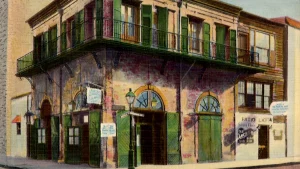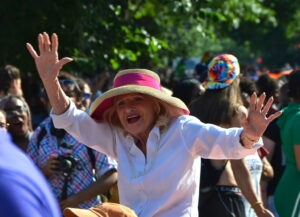As you are coming to the end of your long journey, you’re overwhelmed with the idea that you’ll be home soon, accompanied by warm, familiar faces. However, when you return home, you’re not welcomed by friends and family, but by silence and only the howl of the wind. You look around and not a single soul is in sight. Not one person in your home or in your whole village. A frightening scenario, isn’t it? This was the startling reality that John White and his fellow colonists were faced with when they returned home from their long voyage. His home was none other than the infamous Roanoke Colony.

In 1587, John White led 113 men, women, and children to Roanoke island on behalf of Queen Elizabeth I, in order to establish a New World colony, and claim riches for the queen and people of England.1 The land was somewhat familiar as it had been a previous military outpost.2 However, its first attempt at establishing a colony there had failed. John White and his men were determined not to fail their Queen on this attempt. They especially did not want to fail their investor, Sir Walter Raleigh, like others had in the past. So they went to all extents to make sure their colony’s needs were met.3 The colony seemed to settle well; however, they quickly outgrew supplies, which were essential for the long-term establishment of the colony; so now governor of Roanoke, John White, sailed back to England in order to restock. Upon his arrival in London, he was met with war with Spain and the Spanish Armada, England’s enemy at the time. Storms and many other factors made the return back to Roanoke a long one, one of years, leaving the colonists to wonder when their leader would return.4
Once John White and his men returned, Roanoke was bereft of all its colonists. They recalled that on their way to Roanoke, once already on land, they found a few footprints from Indians.5 However, they made nothing of it at the time. When they reached the village, White came across the letters “CRO” carved on a tree and the word “CROATOAN” carved on a post. Upon further inspection, it seemed that all the houses that the Roanoke Colonist were living in had been dismantled. After seeing this, White was more at ease because he believed that they had relocated to Croatoan, where the Croatoan tribe lived. This was due to the fact that White told the colonists that if they ever relocated, they were to carve the name of their new location somewhere visible. If the move or escape was out of distress, they were also to carve a Maltese cross, but none were in sight. One small thing bothered White though. He had told the colonists to hide his valuables underground, but he found that some were scattered and others were lost. In the end, for a reason unknown, White only looked for the colony one time, but didn’t find them. After this failed attempt, he made no others.6
One question still lingered in the mind of many others: what happened to the Roanoke colonists? It’s said that they were never seen again by Europeans, but there were also many speculated accounts of their whereabouts and fate. In 1608, John Smith wrote in his book that the Indians reported to him of people that looked like him. George Percy, another colonist, reported seeing a white boy with blonde hair among the Indians. Smith later sent two missions towards the south in order to find evidence of the remaining colonists, eventually learning that they were killed.7

Later, a twenty-one-quartz stone was discovered that is believed to have been a “grave marker” for the Roanoke deceased. On the smooth side of the stone was a cross and on the other were passages, speaking of deaths within the colony along with the years.8 As a last matter, in 1612, writer William Strachey reported that the Roanoke Colony did indeed live in harmony with the Chesapeake Indians for twenty-five years. Both the Indians and colonists shared knowledge and lived together until Powhatan, a leader of another Indian tribe called the Powhatan, slaughtered the colonists and the Indians sheltering them in fear that a rival to him would appear from within their tribe. A few of the colonists escaped and were later spared when they were found due to the fact that they worked well with copper, making them valuable. Still many wondered if these were facts or just stories that people wanted to hear.9 In the end, all the evidence points to the fact that the Roanoke colonists are not lost to history, but were rather killed off by brutal Indians. There is no mystery left, it’s just a matter of connecting the dots.
- The Gale Encyclopedia of the Unusual and Unexplained, 2003, s.v. “The Desertion of Roanoke,” by Brad Steiger and Sherry Hanson Steiger; Karenne Wood, “The Roanoke Colony,” South Atlantic Review 77, no. 1/2 (2012): 178-79. ↵
- Lee Miller, Roanoke Solving the Mystery of England’s Lost Colony (London: Pimlico, 2001), 7-9. ↵
- Karenne Wood, “The Roanoke Colony,” South Atlantic Review 77, no. 1/2 (2012): 178-79. ↵
- Lee Miller, Roanoke Solving the Mystery of England’s Lost Colony (London: Pimlico, 2001), 10-11. ↵
- Karen Odahl Kupperman, Roanoke The Abandoned Colony (New Jersey: Rowman & Allanheld, 1984), 133-135. ↵
- Karen Odahl Kupperman, Roanoke The Abandoned Colony (New Jersey: Rowman & Allanheld, 1984), 136-137. ↵
- Karen Odahl Kupperman, Roanoke The Abandoned Colony (New Jersey: Rowman & Allanheld, 1984), 137-139. ↵
- Haywood J. Pearce, “New Light on the Roanoke Colony: A Preliminary Examination of a Stone Found in Chowan County, North Carolina,” The Journal of Southern History 4, no. 2 (1938): 148-150. ↵
- Karen Odahl Kupperman, Roanoke The Abandoned Colony (New Jersey: Rowman & Allanheld, 1984), 139. ↵



114 comments
Vianey Centeno
The writing in this essay was excellent. I had no idea that the Roanoke colony had been massacred by an Indian group. You did a great job of capturing the scene. I actually believed I was there. I’m curious as to why he stopped looking and why he decided to defend his possessions above his own people. After leaving to go on an adventure, he came back to nothing.
Brandon Vasquez
This article was truly interesting to read as the conspiracy behind what happened to the colony of Roanoke is vast and could have ended in many different ways. The introduction caught my eye and made me want to keep reading until the end as you put us into the shoes of what John White saw as he was sailing back and stepping foot back onto the colony.
Brandon Vasquez
This article was truly interesting to read as the conspiracy behind what happened to the colony of Roanoke is vast and could have ended in many different ways. The introduction caught my eye and made me want to keep reading until the end as you put us into the shoes of what John White saw as he was sailing back into the colony.
Eugenio Gonzalez
Great article; I liked how the beginning of the article helps people feel related to the situation. It was interesting to see the perspective of John White and understand his situation of coming back from England and not being able to find anyone. I also believe that the reason why the Roanoke colony disappeared was that unfriendly native Americans attacked it.
Lorena Maldonado
I liked the way it was described in the beginning of the article. It started off very strong and made sure you were not just invested in the people but also the situation and what happened. It definitely drew me in and helped the situation feel more real. There was a good attention to detail, and I liked how it kind of kept it a mystery until the very end because, that left the reader wanting more.
Rafael Portillo
This was scary but in a good way. I really enjoyed your choice of words because it kept my attention. It’s interesting that an entire colony just disappeared in a way. Knowing the time frame and how it was so hard and dangerous to travel I agree that the colonist were killed. However secretly I can also dream that the colonist were left alone and were saved by some friendly Native Americans.
Gabriela Chavarria
I really liked this article I remember learning about it, but this article goes more into detail then what I learned before. I really liked that It gives us theories about what could’ve happened to the Roanoke Colony and even though people are not sure about it almost all the evidence leads to the natives being the reason they disappeared because of the violence and them not really getting along.
Kimberly Rivera
When we were learning about history in elementary and in middle school one oft my favorite sections were about the colonies , specifically Roanoke Colony. I loved how this article didn’t have a specific answer to the colony disappearing but went into possible answers and into stories shared among colonists, it really allowed the reader to try and formulate what possibly happened.
Kenneth Cruz
I like how you put us, the readers, into the perspective of John White and his men at the beginning. Throughout the article, I was impressed with the imagery you used to describe certain scenes such as White finding the letters “CRO” on a tree. I also like how you presented the mystery about the disappearance of the Roanoke and then at the end, tied it all together with evidence to an answer that needed to be connected.
Vianey Centeno
This article was amazing! Personally, reading the cover of this article made it super intriguing but reading it was even more fascinating. My favorite part of the article was when you went ahead and described the instructions that White had left for the colony then he comes back to be very confused and lost. This story was very interesting in finding out the struggle of this colony.